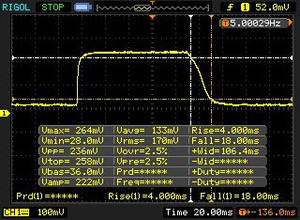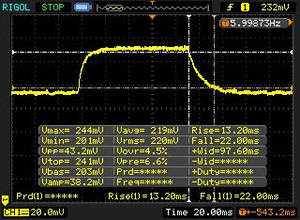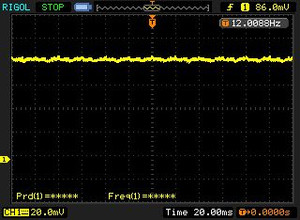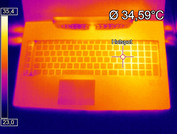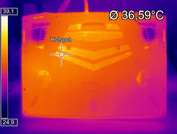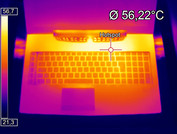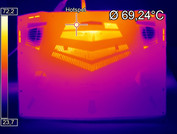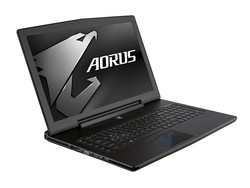Breve análisis del Aorus X7 Pro v5
| |||||||||||||||||||||||||
iluminación: 91 %
Brillo con batería: 271 cd/m²
Contraste: 1178:1 (Negro: 0.23 cd/m²)
ΔE ColorChecker Calman: 4.14 | ∀{0.5-29.43 Ø4.77}
ΔE Greyscale Calman: 4 | ∀{0.09-98 Ø5}
83% sRGB (Argyll 1.6.3 3D)
55% AdobeRGB 1998 (Argyll 1.6.3 3D)
61% AdobeRGB 1998 (Argyll 3D)
83.4% sRGB (Argyll 3D)
66% Display P3 (Argyll 3D)
Gamma: 2.43
CCT: 6558 K
| Aorus X7 Pro v5 LG Philips LP173WF4-SPD1 (LGD046C) | Aorus X5 | Aorus X7 Pro AU Optronics B173HW01 V5 (AUO159D) | Eurocom X8 Chi Mei 173HGE | MSI GT80S 6QF Samsung 184HL (SDC4C48) | |
|---|---|---|---|---|---|
| Display | -1% | 5% | 4% | 4% | |
| Display P3 Coverage (%) | 66 | 61.5 -7% | 67.9 3% | 65.3 -1% | 65.5 -1% |
| sRGB Coverage (%) | 83.4 | 85.7 3% | 88.7 6% | 88.5 6% | 89.2 7% |
| AdobeRGB 1998 Coverage (%) | 61 | 61.8 1% | 64.9 6% | 64.9 6% | 65.2 7% |
| Response Times | 5% | ||||
| Response Time Grey 50% / Grey 80% * (ms) | 35 ? | 35 ? -0% | |||
| Response Time Black / White * (ms) | 22 ? | 20 ? 9% | |||
| PWM Frequency (Hz) | 250 ? | ||||
| Screen | -12% | -14% | -71% | 2% | |
| Brightness middle (cd/m²) | 271 | 324.3 20% | 318 17% | 267.9 -1% | 298 10% |
| Brightness (cd/m²) | 257 | 317 23% | 283 10% | 254 -1% | 265 3% |
| Brightness Distribution (%) | 91 | 87 -4% | 82 -10% | 78 -14% | 78 -14% |
| Black Level * (cd/m²) | 0.23 | 0.553 -140% | 0.54 -135% | 0.62 -170% | 0.35 -52% |
| Contrast (:1) | 1178 | 586 -50% | 589 -50% | 432 -63% | 851 -28% |
| Colorchecker dE 2000 * | 4.14 | 3.53 15% | 3.79 8% | 10.39 -151% | 2.72 34% |
| Colorchecker dE 2000 max. * | 8.11 | 5.4 33% | |||
| Greyscale dE 2000 * | 4 | 3.12 22% | 2.35 41% | 10.96 -174% | 3 25% |
| Gamma | 2.43 91% | 2.28 96% | 2.37 93% | 2.51 88% | 2.36 93% |
| CCT | 6558 99% | 6600 98% | 6775 96% | 13449 48% | 6995 93% |
| Color Space (Percent of AdobeRGB 1998) (%) | 55 | 55.4 1% | 58 5% | 57 4% | 58 5% |
| Color Space (Percent of sRGB) (%) | 83 | 85.2 3% | 89 7% | ||
| Media total (Programa/Opciones) | -7% /
-9% | -5% /
-9% | -34% /
-51% | 4% /
3% |
* ... más pequeño es mejor
Top 10 Análisis
» Top 10 Portátiles Multimedia
» Top 10 Portátiles de Juego
» Top 10 Portátiles de Juego ligeros
» Top 10 Portátiles Asequibles de Oficina/Empresa
» Top 10 Portátiles de Juego Ligeros
» Top 10 Portátiles de Oficina/Empresa Premium
» Top 10 Estaciones de Trabajo
» Top 10 Subportátiles
» Top 10 Ultrabooks
» Top 10 Convertibles
» Top 10 Tablets
» Top 10 Tablets Windows
» Top 10 Tablets de menos de 250 Euros
» Top 10 Phablets (>5.5")
» Top 10 Smartphones
» Top 10 Smartphones (≤5")
» Top 10 Smartphones de menos de 300 Euros
» Top 10 Smartphones de menos de 120 Euros
» Top 10 Portátiles de menos de 1000 Euros
» Top 10 Portátiles de menos de 500 Euros
» Top 10 Portátiles de menos de 300 Euros
» Los Mejores Displays de Portátiles Analizados por Notebookcheck
Tiempos de respuesta del display
| ↔ Tiempo de respuesta de Negro a Blanco | ||
|---|---|---|
| 22 ms ... subida ↗ y bajada ↘ combinada | ↗ 4 ms subida | |
| ↘ 18 ms bajada | ||
| La pantalla mostró buenos tiempos de respuesta en nuestros tests pero podría ser demasiado lenta para los jugones competitivos. En comparación, todos los dispositivos de prueba van de ##min### (mínimo) a 240 (máximo) ms. » 47 % de todos los dispositivos son mejores. Eso quiere decir que el tiempo de respuesta es similar al dispositivo testado medio (20.2 ms). | ||
| ↔ Tiempo de respuesta 50% Gris a 80% Gris | ||
| 35 ms ... subida ↗ y bajada ↘ combinada | ↗ 13 ms subida | |
| ↘ 22 ms bajada | ||
| La pantalla mostró tiempos de respuesta lentos en nuestros tests y podría ser demasiado lenta para los jugones. En comparación, todos los dispositivos de prueba van de ##min### (mínimo) a 636 (máximo) ms. » 47 % de todos los dispositivos son mejores. Eso quiere decir que el tiempo de respuesta es peor que la media (31.6 ms) de todos los dispositivos testados. | ||
Parpadeo de Pantalla / PWM (Pulse-Width Modulation)
| Parpadeo de Pantalla / PWM no detectado | |||
Comparación: 53 % de todos los dispositivos testados no usaron PWM para atenuar el display. Si se usó, medimos una media de 8088 (mínimo: 5 - máxmo: 343500) Hz. | |||
| Cinebench R15 | |
| CPU Single 64Bit | |
| MSI GT80S 6QF | |
| Schenker XMG U716 | |
| Eurocom X8 | |
| Aorus X7 Pro v5 | |
| Alienware 17 R3 (A17-9935) | |
| Acer Predator 17 G9-791-75PV | |
| CPU Multi 64Bit | |
| MSI GT80S 6QF | |
| Schenker XMG U716 | |
| Eurocom X8 | |
| Aorus X7 Pro v5 | |
| Alienware 17 R3 (A17-9935) | |
| Acer Predator 17 G9-791-75PV | |
| Cinebench R11.5 | |
| CPU Single 64Bit | |
| MSI GT80S 6QF | |
| Schenker XMG U716 | |
| Eurocom X8 | |
| Aorus X7 Pro v5 | |
| Alienware 17 R3 (A17-9935) | |
| Acer Predator 17 G9-791-75PV | |
| CPU Multi 64Bit | |
| MSI GT80S 6QF | |
| Schenker XMG U716 | |
| Aorus X7 Pro v5 | |
| Eurocom X8 | |
| Alienware 17 R3 (A17-9935) | |
| Acer Predator 17 G9-791-75PV | |
| PCMark 7 Score | 5816 puntos | |
ayuda | ||
| PCMark 7 - Score | |
| MSI GT80S 6QF | |
| Schenker XMG U716 | |
| Eurocom X8 | |
| Acer Predator 17 G9-791-75PV | |
| Alienware 17 R3 (A17-9935) | |
| Aorus X7 Pro v5 | |
| Aorus X7 Pro v5 Samsung SM951 MZVPV512 m.2 PCI-e | Acer Predator 17 G9-791-75PV Lite-On CV1-8B256 | Alienware 17 R3 (A17-9935) Samsung PM951 NVMe 512 GB | Schenker XMG U716 Samsung SM951 MZHPV512HDGL m.2 PCI-e | Eurocom X8 Samsung SSD 840 EVO 120GB mSATA | MSI GT80S 6QF 2x Samsung SM951 MZVPV256HDGL (RAID 0) | |
|---|---|---|---|---|---|---|
| CrystalDiskMark 3.0 | -70% | -28% | -10% | -48% | 34% | |
| Read Seq (MB/s) | 1736 | 484.5 -72% | 1263 -27% | 1608 -7% | 514 -70% | 3259 88% |
| Write Seq (MB/s) | 1562 | 357.8 -77% | 587 -62% | 1577 1% | 495.4 -68% | 2556 64% |
| Read 4k (MB/s) | 51.9 | 20.8 -60% | 42.59 -18% | 44.95 -13% | 37.77 -27% | 49.38 -5% |
| Write 4k (MB/s) | 148 | 42.65 -71% | 140.6 -5% | 119.5 -19% | 111.1 -25% | 130.3 -12% |
| 3DMark 06 Standard Score | 27179 puntos | |
| 3DMark Vantage P Result | 36920 puntos | |
| 3DMark 11 Performance | 14777 puntos | |
| 3DMark Ice Storm Standard Score | 102972 puntos | |
| 3DMark Cloud Gate Standard Score | 25241 puntos | |
| 3DMark Fire Strike Score | 10655 puntos | |
ayuda | ||
| 3DMark | |
| 1920x1080 Fire Strike Score | |
| MSI GT80S 6QF | |
| Eurocom X8 | |
| Schenker XMG U716 | |
| Aorus X7 Pro v5 | |
| Alienware 17 R3 (A17-9935) | |
| Acer Predator 17 G9-791-75PV | |
| 1920x1080 Fire Strike Graphics | |
| MSI GT80S 6QF | |
| Eurocom X8 | |
| Aorus X7 Pro v5 | |
| Schenker XMG U716 | |
| Alienware 17 R3 (A17-9935) | |
| Acer Predator 17 G9-791-75PV | |
| 3DMark 11 | |
| 1280x720 Performance | |
| MSI GT80S 6QF | |
| Eurocom X8 | |
| Aorus X7 Pro v5 | |
| Schenker XMG U716 | |
| Alienware 17 R3 (A17-9935) | |
| Acer Predator 17 G9-791-75PV | |
| 1280x720 Performance GPU | |
| MSI GT80S 6QF | |
| Eurocom X8 | |
| Aorus X7 Pro v5 | |
| Schenker XMG U716 | |
| Alienware 17 R3 (A17-9935) | |
| Acer Predator 17 G9-791-75PV | |
| Unigine Heaven 4.0 - Extreme Preset DX11 | |
| MSI GT80S 6QF | |
| Aorus X7 Pro v5 | |
| Schenker XMG U716 | |
| Acer Predator 17 G9-791-75PV | |
| bajo | medio | alto | ultra | 4K | |
|---|---|---|---|---|---|
| Batman: Arkham Knight (2015) | 119 | 108 | 59 | 39 | 18 |
| Mad Max (2015) | 225 | 157.4 | 145.1 | 49.7 | |
| FIFA 16 (2015) | 302.4 | 247 | 173.1 | 70.8 | |
| Anno 2205 (2015) | 116.3 | 110.3 | 55.6 | 17.5 | 21.4 |
| Call of Duty: Black Ops 3 (2015) | 141.1 | 138.4 | 109.2 | 98.9 | 36 |
| Fallout 4 (2015) | 145.9 | 139.2 | 96 | 78.4 | 32.4 |
| Star Wars Battlefront (2015) | 199.8 | 196.9 | 127.1 | 109.3 | 40.8 |
| Assassin's Creed Syndicate (2015) | 83.6 | 81.4 | 76.3 | 37.6 | 30.8 |
| Rainbow Six Siege (2015) | 234.5 | 185.5 | 110.7 | 94.6 | 33.5 |
| Just Cause 3 (2015) | 127.6 | 104.5 | 60.1 | 51.7 | 21.3 |
| Rise of the Tomb Raider (2016) | 78.7 | 72.4 | 71.4 | 68 | 31.9 |
| XCOM 2 (2016) | 94.6 | 80.2 | 67.2 | 31.7 | |
| Far Cry Primal (2016) | 69 | 64 | 63 | 60 | 27 |
| The Division (2016) | 161.3 | 129.4 | 71.9 | 54.9 | 26.2 |
| Hitman 2016 (2016) | 60.7 | 60.3 | 52.2 | 50.2 | 25.1 |
| Need for Speed 2016 (2016) | 107.6 | 102.5 | 90.7 | 68.1 | 37.1 |
Ruido
| Ocioso |
| 34 / 35 / 39 dB(A) |
| Carga |
| 39 / 54 dB(A) |
 | ||
30 dB silencioso 40 dB(A) audible 50 dB(A) ruidosamente alto |
||
min: | ||
| Aorus X7 Pro v5 GeForce GTX 970M SLI, 6820HK | Aorus X5 GeForce GTX 965M SLI, 5700HQ | Aorus X7 Pro GeForce GTX 970M SLI, 4870HQ | Eurocom X8 GeForce GTX 980M SLI, 4940MX | MSI GT80S 6QF GeForce GTX 980 SLI (Laptop), 6820HK | |
|---|---|---|---|---|---|
| Noise | 1% | -5% | -13% | -10% | |
| apagado / medio ambiente * (dB) | 30 | ||||
| Idle Minimum * (dB) | 34 | 32.5 4% | 29.5 13% | 40.5 -19% | 34 -0% |
| Idle Average * (dB) | 35 | 32.6 7% | 32.1 8% | 41.4 -18% | 36 -3% |
| Idle Maximum * (dB) | 39 | 34.4 12% | 41 -5% | 41.6 -7% | 40 -3% |
| Load Average * (dB) | 39 | 44 -13% | 52.3 -34% | 45.6 -17% | 51 -31% |
| Load Maximum * (dB) | 54 | 56.8 -5% | 57.9 -7% | 55 -2% | 60 -11% |
* ... más pequeño es mejor
(-) La temperatura máxima en la parte superior es de 55.4 °C / 132 F, frente a la media de 40.4 °C / 105 F, que oscila entre 21.2 y 68.8 °C para la clase Gaming.
(-) El fondo se calienta hasta un máximo de 62.4 °C / 144 F, frente a la media de 43.3 °C / 110 F
(+) En reposo, la temperatura media de la parte superior es de 31.8 °C / 89# F, frente a la media del dispositivo de 33.9 °C / 93 F.
(-) El reposamanos y el touchpad pueden calentarse mucho al tacto con un máximo de 45 °C / 113 F.
(-) La temperatura media de la zona del reposamanos de dispositivos similares fue de 28.8 °C / 83.8 F (-16.2 °C / -29.2 F).
| Aorus X7 Pro v5 GeForce GTX 970M SLI, 6820HK | Aorus X5 GeForce GTX 965M SLI, 5700HQ | Aorus X7 Pro GeForce GTX 970M SLI, 4870HQ | Eurocom X8 GeForce GTX 980M SLI, 4940MX | MSI GT80S 6QF GeForce GTX 980 SLI (Laptop), 6820HK | |
|---|---|---|---|---|---|
| Heat | -4% | -18% | 20% | -0% | |
| Maximum Upper Side * (°C) | 55.4 | 55.6 -0% | 61.2 -10% | 44 21% | 45.7 18% |
| Maximum Bottom * (°C) | 62.4 | 57.6 8% | 59.1 5% | 41.6 33% | 61 2% |
| Idle Upper Side * (°C) | 33.6 | 36.2 -8% | 43.9 -31% | 30 11% | 36.4 -8% |
| Idle Bottom * (°C) | 34.6 | 39.4 -14% | 46.8 -35% | 29.8 14% | 39.2 -13% |
* ... más pequeño es mejor
| Off / Standby | |
| Ocioso | |
| Carga |
|
Clave:
min: | |
| Aorus X7 Pro v5 GeForce GTX 970M SLI, 6820HK | Aorus X5 GeForce GTX 965M SLI, 5700HQ | Aorus X7 Pro GeForce GTX 970M SLI, 4870HQ | Eurocom X8 GeForce GTX 980M SLI, 4940MX | MSI GT80S 6QF GeForce GTX 980 SLI (Laptop), 6820HK | |
|---|---|---|---|---|---|
| Power Consumption | -5% | -52% | |||
| Idle Minimum * (Watt) | 32 | 29 9% | 44 -38% | ||
| Idle Average * (Watt) | 37 | 34.8 6% | 53 -43% | ||
| Idle Maximum * (Watt) | 42 | 40.6 3% | 62 -48% | ||
| Load Average * (Watt) | 101 | 132 -31% | 163 -61% | ||
| Load Maximum * (Watt) | 245 | 276 -13% | 411 -68% |
* ... más pequeño es mejor
| Aorus X7 Pro v5 94.24 Wh | Aorus X5 73 Wh | Aorus X7 Pro 73 Wh | Eurocom X8 89 Wh | MSI GT80S 6QF 75 Wh | |
|---|---|---|---|---|---|
| Duración de Batería | -10% | -4% | -22% | -25% | |
| Reader / Idle (h) | 3 | 2.8 -7% | 3 0% | 2.5 -17% | 2.5 -17% |
| WiFi v1.3 (h) | 2.5 | 1.9 -24% | |||
| Load (h) | 1.5 | 1.5 0% | 1.4 -7% | 1.1 -27% | 1 -33% |
| WiFi (h) | 1.5 |
Pro
Contra
Dejando a un lado la corta duración de la batería y el fastidio del driver GPU desfasado, el Aorus X7 Pro v5 da un buen rendimiento general.
A pesar de la delgada construcción y de la segunda tarjeta gráfica, este dispositivo no es más ruidoso o caliente que muchos rivales de 17" (aunque se pone serio en modo 3D).
Gigabyte también merece alabanzas por la mejorada calidad de sonido, la mejor construcción, la pantalla de alto contraste y por instalar un SSD PCIe o NVMe. En general, el usuario tiene un equipo ideal para el futuro con el X7 Pro v5. USB 3.1, G-Sync, 16 GB de RAM DDR4 y 2x 6 GB de VRAM hablan por sí mismos. Las útiles herramientas (gestión de ventilador, etc) también son ganchos de venta únicos.
Vemos posibilidad de mejora en el sensible touchpad, el alcance de la Wi-, la posición del teclado y la distribución de interfaces. Quien quiera una experiencia de juego lo más libre d eestrés posible (palabra clave: dependencia de driver) estará mejor con un portátil de GPU única con una GTX 980M o GTX 980 por ahora.
Ésta es una versión acortada del análisis original. Puedes leer el análisis completo en inglés aquí.
Aorus X7 Pro v5
- 04/18/2016 v5.1 (old)
Florian Glaser




